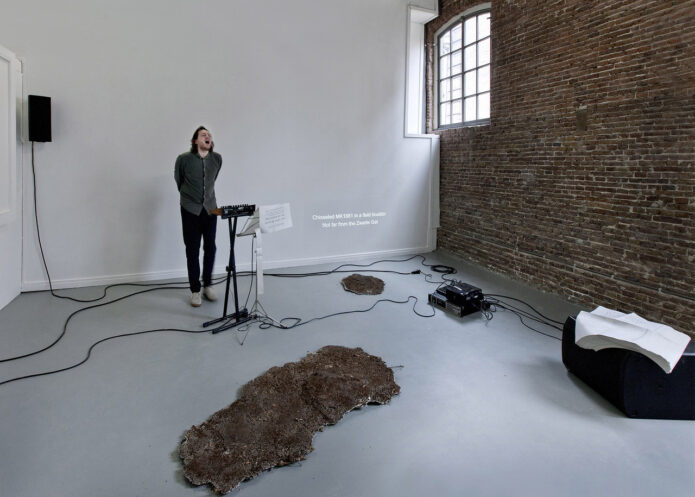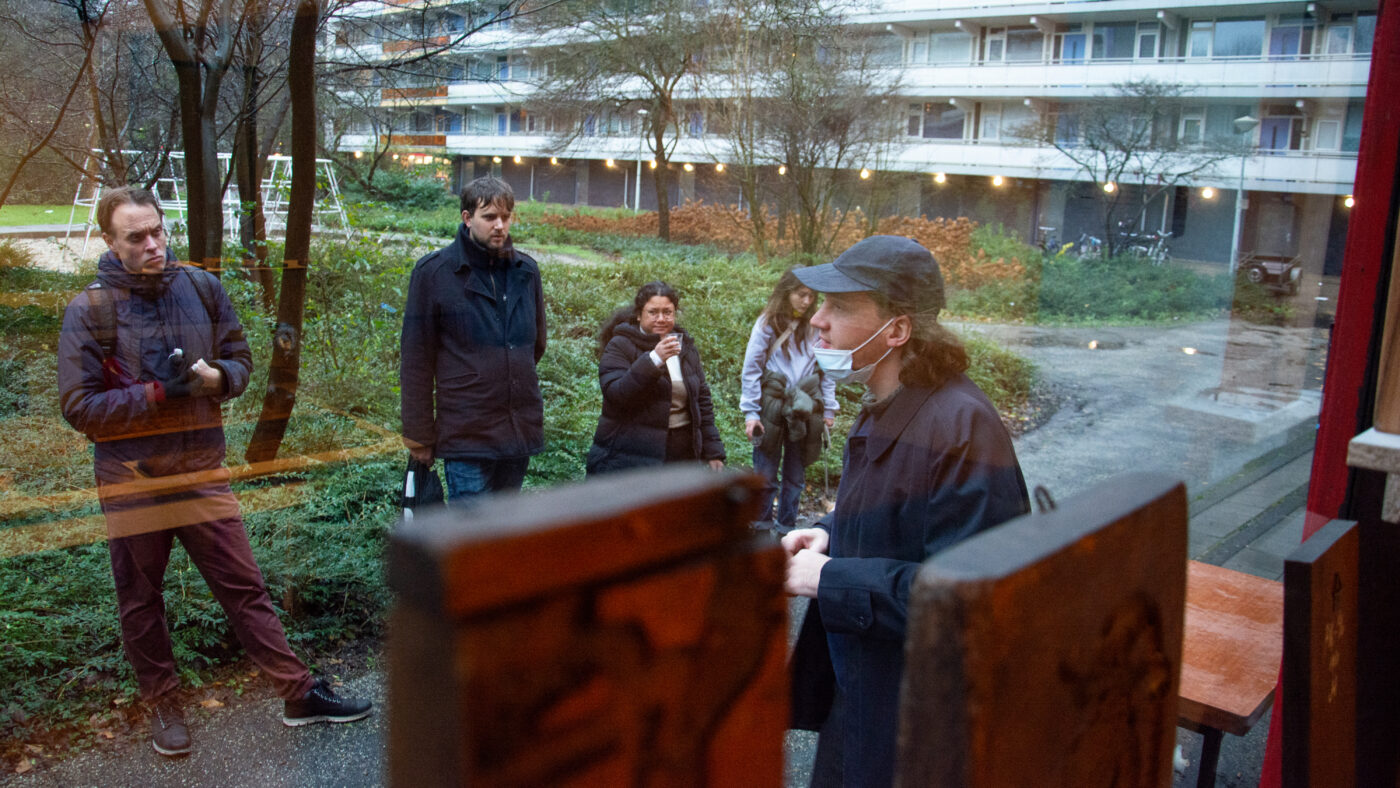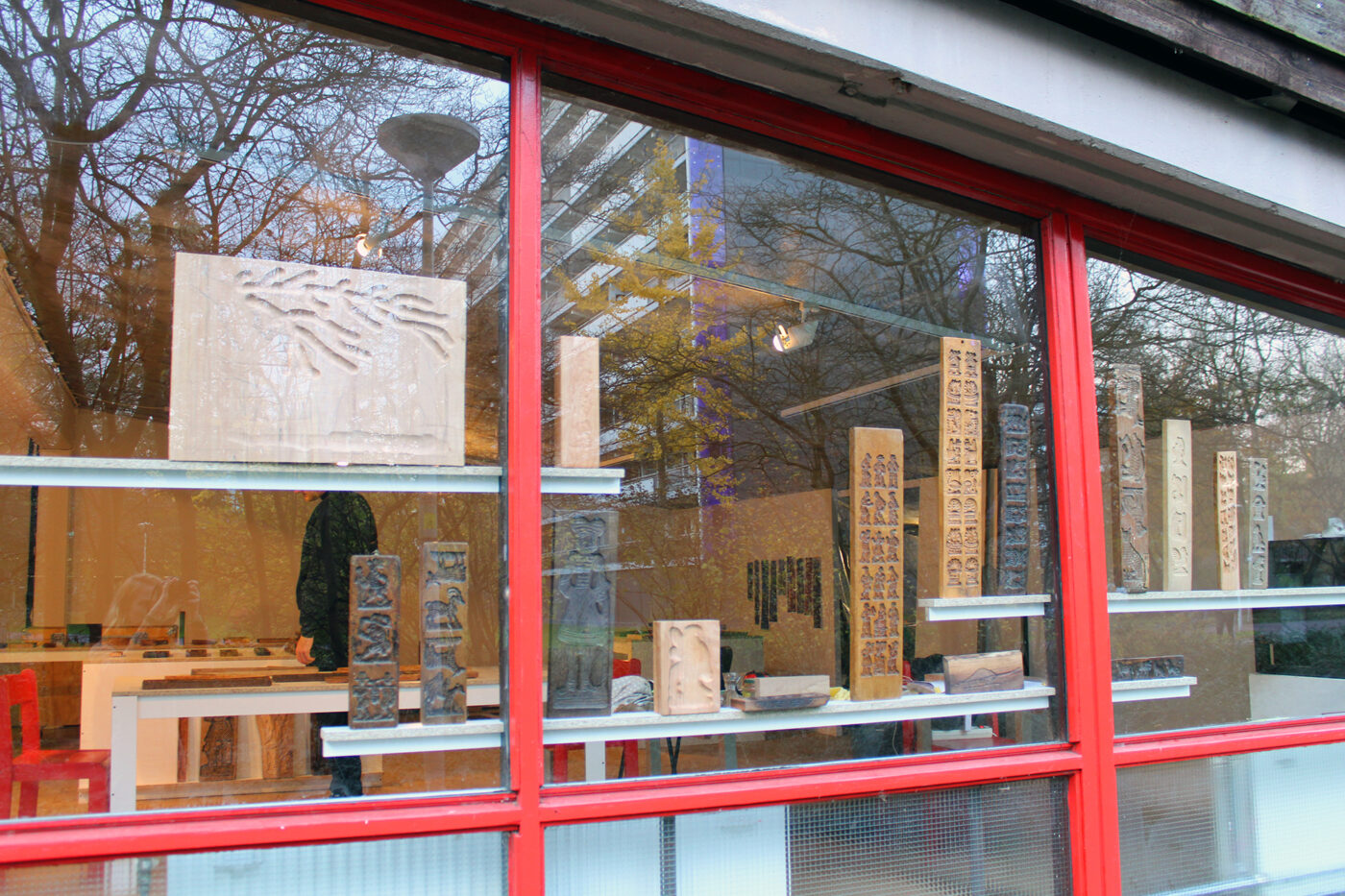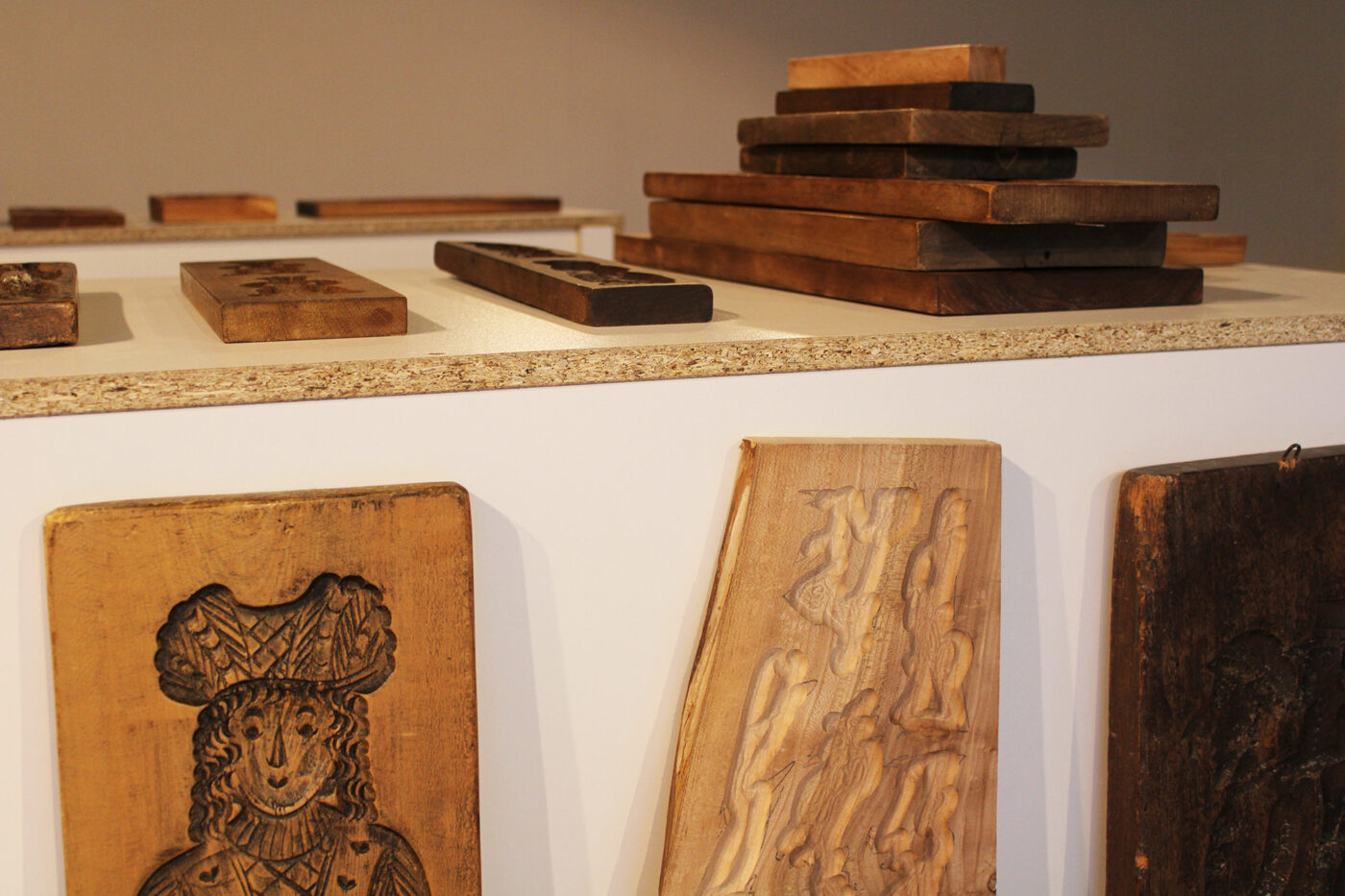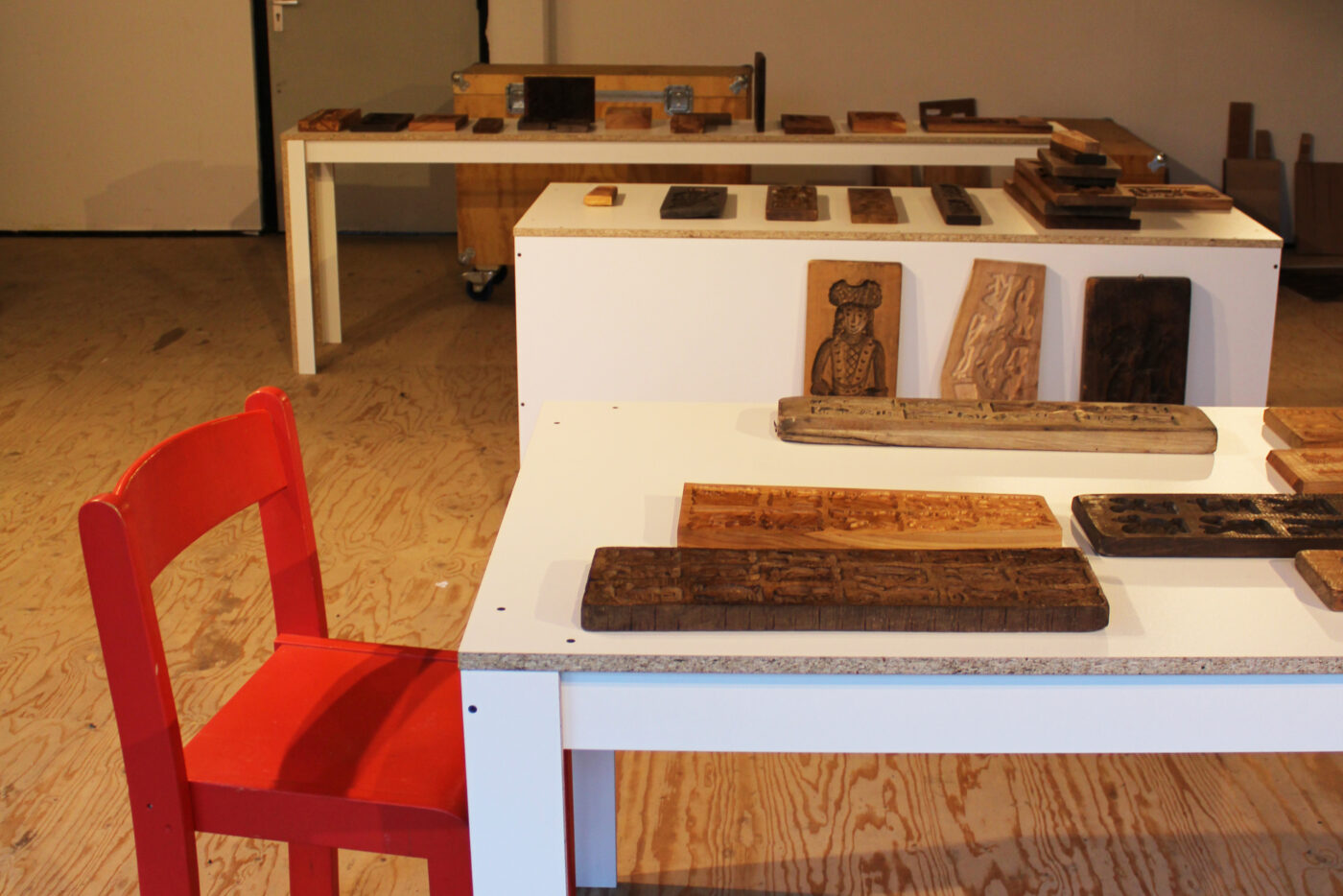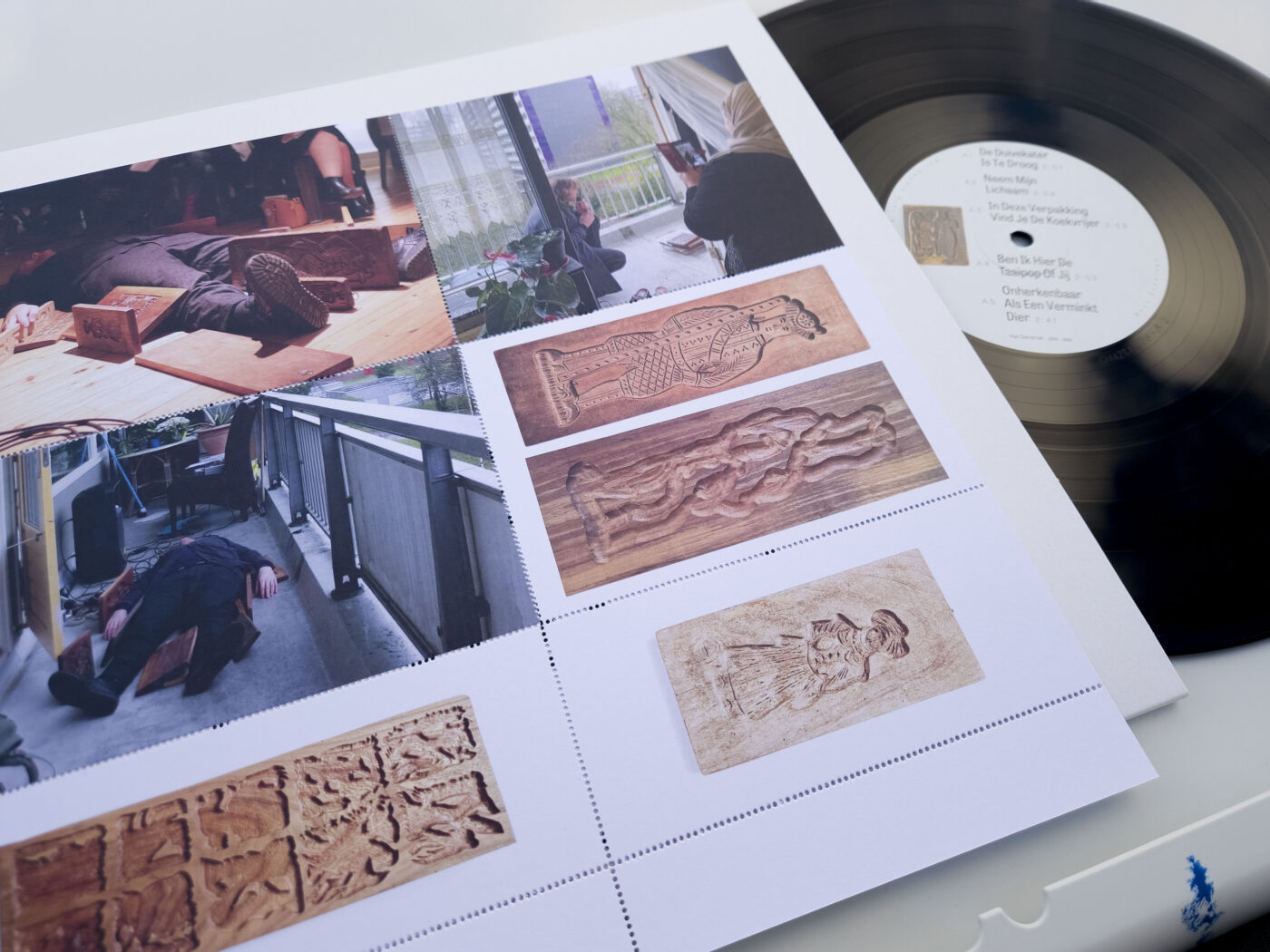Interview: Looking for hidden meanings with Bert Scholten
By Milo Vermeire
January 2022
Artist Bert Scholten (1988) sees a wealth of local customs and traditions in the Netherlands. He uses traces of the past to tell new stories. For his residency at Werkplaats Molenwijk, the artist brought a whole stack of wooden bread moulds or ‘koekplanken’ with him. Over the past few months, he and the residents have been looking into the hidden meanings that these pieces of heritage carry with them. Amongst other things, he gave workshops, balcony concerts and organized the exhibition GEEF (2021-2022).
While we sit between the stacks of koekplanken, the artist explains once again where this traditional cookware actually comes from. The moulds are elongated pieces of wood with a shape gouged into it so that you can use it as a baking tin. Their origin can be found in pagan sacrificial cultures. Through the course of history, the animal sacrifice changed to a bread in the shape of an animal, which then developed further into a bread mould. Craftsmen made wooden moulds so that bread or cakes could be pressed into all kinds of shapes. The result of this transformation from animal sacrifice to the cake, forms the starting point of Scholten’s dialogue with the inhabitants of the Molenwijk.
You’ve been working on ‘koekplanken’ for over two years now. What sparked your fascination for this almost forgotten tradition?
My grandfather was a baker and the first two moulds I got belonged to him. These hung in the stairwell at my parents’ house and that’s why I started to delve into the history of bread. First, I copied my grandfather’s moulds. Since then I also collect them through second-hand shops and via Marktplaats. Many of the koekplanken you’ll encounter depict professions from the old guilds, soldier-types, and common men and women. But there are also many with depictions of animals. For me, even more important than the depictions are the customs surrounding it. If you gave someone a cake baked in a cake board, it had a certain meaning. However, that meaning was mostly hidden.
Can you give an example of such a ‘hidden’ meaning?
The simplest example is the pig. This animal represents gluttony, so if you got a cake in the shape of a pig, it was usually an unkind gesture. But there are also more complex meanings. For example, one of the moulds I have here shows a man in a hat. He sits on the back of a peasant woman with a bubble of snot coming out of her nose. The man is very small. A cake from this mould is a guessing game about the meaning. If you got it as a man, it probably says something about your relationship, but it could mean a lot more.
These kinds of hidden meanings were reinforced during the Reformation when many pagan representations were banned. Almost all of them were hidden in the world of children’s stories. For example, sexual matters were hidden in childish imagery. Not immediately readable, but if you know the code language you can decipher it. This goes as far as, for example, a pair of glasses on a nose being code for a penis.
Why did you take the bread moulds into the Molenwijk?
There is meaning in all those representations, but they are difficult to read. You can feel it’s importance, but you can’t quite interpret it. I like to redefine that. To take the space to give it new meanings. If you give someone a cake from a mould, you can feel the meaning, but you can usually not interpret it completely. So it is also about the attempt to guess or incite the hidden meaning in the receiver.
The word ‘speculaas’ (a type of Dutch spiced shortcrust biscuit) comes from the Latin ‘speculum’ which means mirror. This origin is not entirely certain, but it fits very well because you push the dough into the mould and the image comes mirrored. At the same time, the very act of giving certain images also has a mirror effect. As the recipient of the cake, you receive something that is actually a mirror to yourself.

GEEF by Bert Scholten. Foto: © Eyas Matouk / Werkplaats Molenwijk
In your previous work you have dealt with stories from the past as well as contemporary stories that take place on a very local level. Your work with the koekplanken seems, perhaps even more than about the past, to be about the future. Do you see it that way?
Absolutely. I am filling in those stories, but I also want to keep them open. I want to make suggestions but not make the stories all mine. The residency is a good way to see how people respond to certain stories. I’ve been displaying the koekplanken here from the start and you can see how people from different generations react to it. For example, quite a lot of elderly people live here who used to live in the Jordaan. They know them from their childhood. They recognize the visual language, and I have often seen them here looking and pointing. There are also completely different groups here that don’t know it at all, but still recognize things. If you talk with children from the neighbourhood about what a sacrifice is, where the story of the koekplanken begins, there are often many commonalities. Because sacrifice occurs in many cultures. While a sacrificial culture may seem the most remote from Dutch culture because it has largely disappeared from it.
The koekplanken have gone from religious objects to utilitarian objects, to commercial objects, to decorative objects. They now hang on the wall instead of being in the baker’s cupboard. I think it’s nice to take them off that wall and give them a function again. An object that is moving again.
You regularly work with ‘living history’ and the stories of residents in smaller communities. For example, you previously made a newspaper for the residents of Oude Pekela and you dived into a series of news articles about windmill terrorism in the north of the Netherlands. Often, you already know the places and their specific histories. The Molenwijk however, was completely unknown to you. You are not from this neighbourhood and not from Amsterdam. How did it feel to stay here as a resident?
I think that as an artist-in-residence you are always a kind of outsider. It’s always a case of ‘I’m not from here, what am I actually doing here?’ However, it is easy to make contact with the people who pass by in the workshop. At the same time, the surrounding flats are overwhelming. People all live higher up, which means that sometimes very little happens on the ground floor. You don’t get to that upper world as quickly as a non-resident, so life seems to take place a bit further away.
I’m not much of an outgoing person myself, so I thought workshops would be the best way to make contact. The cakes are about the meaning of gift giving and I thought it would be nice to think about this together with children. How do they feel about gifts and who would they like to give something to? In this way, the cakes also enter the flats. That was fun, but in the long run it turned out to be not so easy to mobilize those children every time. At the same time, sometimes it’s ok if something doesn’t quite work out the way you had planned. Oftentimes, other things happen. In this case, which was the balcony concerts, which turned out to be a much more direct way to tell the stories.
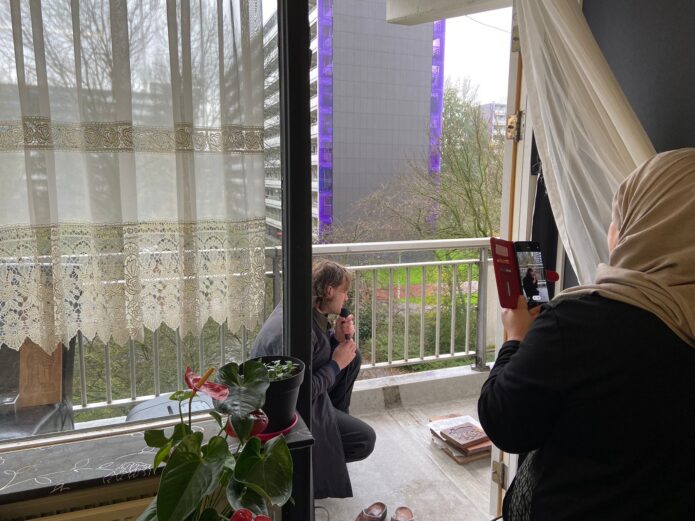
Bert Scholten at Werkplaats Molenwijk, photo: Margot van Ruitenbeek / Framer Framed
What did those balcony concerts look like?
I made a new music album based on those koekplanken. I´ve got about twenty songs in which I poetically and by mixing fantasy and history, tell the hidden stories. I liked that the balconies in the Molenwijk form a boundary between public and private space. I then sang songs on a number of balconies. Each time, I took a stack of koekplanken with me for my performance. During the performance I quickly noticed that it was also about the hospitality of the residents. At first I thought I would sing from the balconies to the people below, but that turned out to be of secondary importance. It was mainly about the interaction with the residents.
How did they react to your performance?
People often thought it was special. The conversations we had afterwards were usually a bit short because we had to build down, but prior to the performance you really get to know each other. It’s nice that you never know where you’ll end up. It’s a total surprise every time. You enter the home with all your stuff, the sound installation – which is quite heavy – and a stack of koekplanken, and then in some homes you have to take off your shoes. In those cases we were given sandals to wear on the balcony. It’s details like that which may not matter for the songs, but they do for the whole of the project. I just reviewed the recordings and noticed that I sang very differently every concert.
Do you think that through the stories you heard during the workshops and the concerts, you have a good idea of what the story of the Molenwijk is?
That’s a question that concerns a lot of people. If you have a lot of time you might be able to answer that, but that’s a kind of question that might not be part of my profession. At those balcony concerts you know at a certain point with whom you are dealing. You enter someone’s house, you have people in front of you and you sing a certain song for them. It is something very different than if you had to say something in general about the entire neighbourhood. That would quickly become a huge generalization. I enjoy the social practice best when it can take place from individual to individual. Instead of group to group or myself to a group.
In any case, it is quite confrontational to do something in a neighbourhood. What will remain of your art? It is a struggle, but it always gives a different perspective. If I hadn’t been here I would never have stood on those balconies.
Is what the audience ultimately does with the project, essential for you? That they continue with the stories you provide?
Yes, because it is a kind of retelling of a story, and in that retelling it matters a lot who the listener is, who talks back or not. I’ve been in constant contact with an Afghan man with whom I can’t really talk. He does not speak Dutch or English. But with hand gestures, I talked a lot about the boards with him. Every time I had put a new board in the window, he would come to have a look. In these cases it is really purely about shapes, pointing out things and noticing differences. Then I also notice that the language or the explanation may be less relevant. It’s more about what’s really there to see. The meaning is palpable.
Bert Scholte’s residency ended with the exhibition GEEF (2021-2022) where he shows new work – including a new video work – that he made during his stay at Werkplaats Molenwijk in Amsterdam North. The video was later shown at TENT in Rotterdam as part of the exhibition That doesn’t play here (2022). In addition, an LP of the same name was released in 2023 with recordings made in the Werkplaats, among other things.

Bert Scholte, Dat speelt hier niet (2023), vinyl record
Molenwijk / Amsterdam Noord / Artist Talk / Community & Learning / Residencies /
Exhibitions
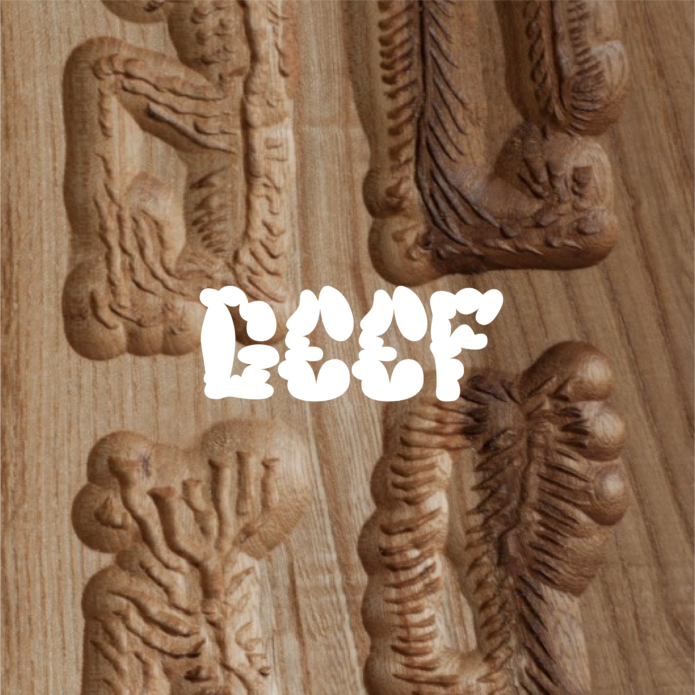
Exhibition: GEEF
Werkplaats Molenwijk exhibition by Bert Scholten
Network
